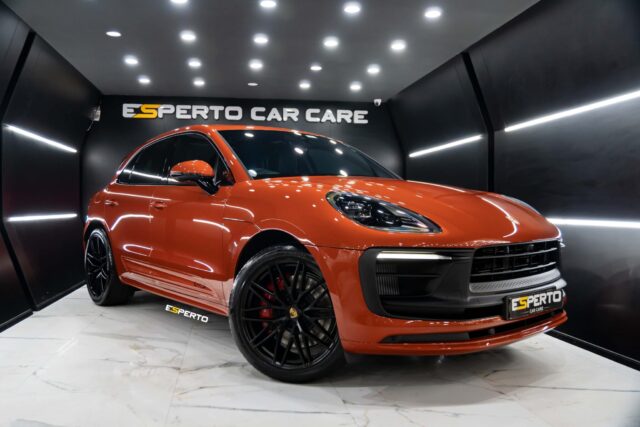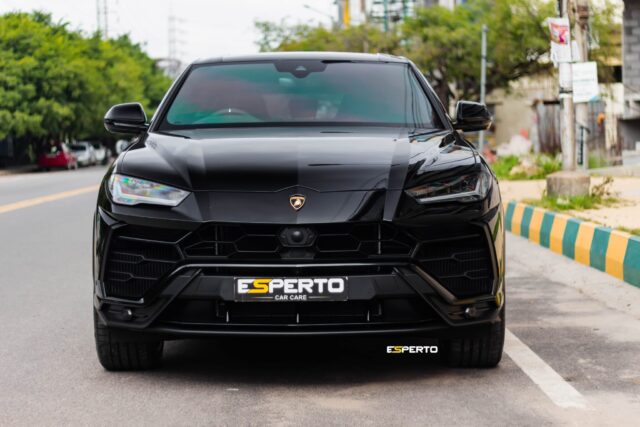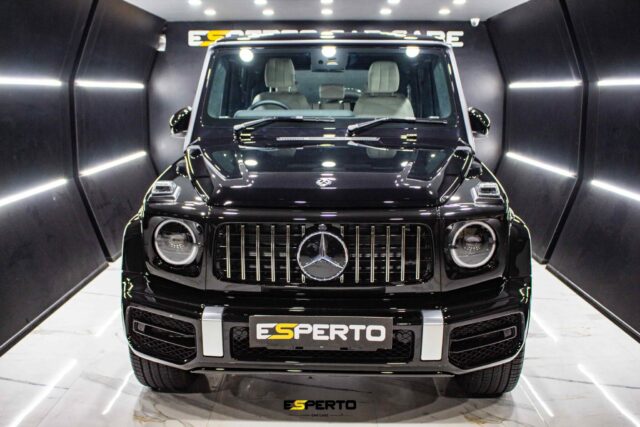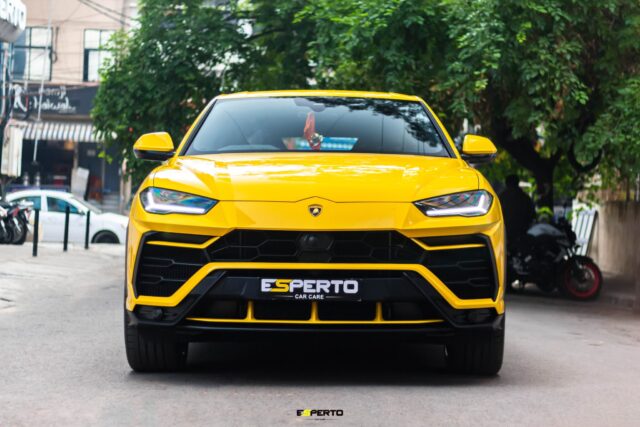The installation cost of Paint Protection Film (PPF) on a vehicle typically ranges from ₹1,25,000 to ₹5,80,000, depending on various factors such as the vehicle’s size, the extent of coverage—whether partial or full—and the quality of the film being applied. Additional considerations include the installation’s complexity and the installer’s reputation. Established and reputable installers often charge a premium due to their proven track record of delivering high-quality results.
Smaller vehicles or partial coverage options may be more affordable, while high-end luxury cars and full-body installations using premium self-healing films tend to be more expensive. Exploring various brands and installation options can provide valuable insights for those interested in the specific benefits and types of PPF available. The PPF coating price also varies depending on the features offered, such as hydrophobic properties or enhanced durability.
What is PPF and How Does It Protect Your Car?
Paint Protection Film (PPF) is a thin, transparent protective film applied to a vehicle’s exterior to safeguard the paint from damage.
This film functions by absorbing or deflecting harmful impacts from road debris, UV light, and minor abrasions, thereby preserving the vehicle’s aesthetic and resale value. Many detailing services now offer PPF as part of their packages to help car owners maintain their vehicles in pristine condition.
PPF offers significant benefits, including reduced maintenance costs and enhanced car exterior longevity.
Explaining the Basics of Paint Protection Film
Many car owners are turning to Paint Protection Film (PPF) as a robust solution to safeguard their vehicle’s exterior. This protective film, often installed on cars, helps maintain the vehicle’s pristine condition by shielding it from environmental elements and minor scratches.
Known for its self-healing properties, PPF can repair itself from minor abrasions, preserving the car’s appearance over time. This technology has gained significant popularity among car enthusiasts seeking to maintain their vehicle’s original appearance.
Key Benefits of Paint Protection Film:
- Durability: Features an industry-leading multilayer construction that guards against wear and tear.
- Aesthetic Preservation: Maintains the original look of the car’s paint by protecting against surface scratches and contaminants.
- Cost-Effectiveness: Reduces the need for frequent repaints, balancing initial paint protection film prices with long-term savings.
How PPF Works to Protect the Car’s Paint
Understanding how Paint Protection Film (PPF) safeguards a vehicle’s exterior is integral to appreciating its value.
PPF is a transparent film applied as a protective coating over the car’s paint to shield it from environmental damage and minor abrasions. This PPF film serves as a barrier to protect the paint from scratches, stains, and other surface imperfections. The decision to install PPF on a car varies based on factors like usage frequency and exposure to environmental elements, and the owner’s long-term maintenance goals.
Particularly beneficial for cars, PPF for cars incorporates self-healing properties that allow it to repair itself from minor scratches, enhancing the longevity of the vehicle’s paint. Vehicle owners who drive their car regularly often opt for full-body PPF coverage to ensure comprehensive protection.
The installation of PPF coating on a vehicle involves meticulous application to guarantee that the protective layer adheres smoothly, maintaining the car detailing and aesthetic appearance while providing robust protection.
Benefits of Using Protection Films for Your Vehicle
Although initially invisible to the naked eye, the benefits of using Paint Protection Film (PPF) on vehicles are substantial and multifaceted. This specialized ppf coating for car exteriors protects the paint from damage, preserving the vehicle’s aesthetic appeal and structural integrity over time.
The advantages of applying PPF can be summarized in three key points:
- Protection Against Environmental Damages: PPF protects against scratches, stone chips, and chemical stains that mar the car’s paintwork.
- Enhanced Durability: The film enhances the vehicle’s paint longevity, minimizing the need for frequent touch-ups and repairs.
- Increased Resale Value: Maintaining the car’s exterior condition can lead to increased resale value, as the car protection remains high-quality.
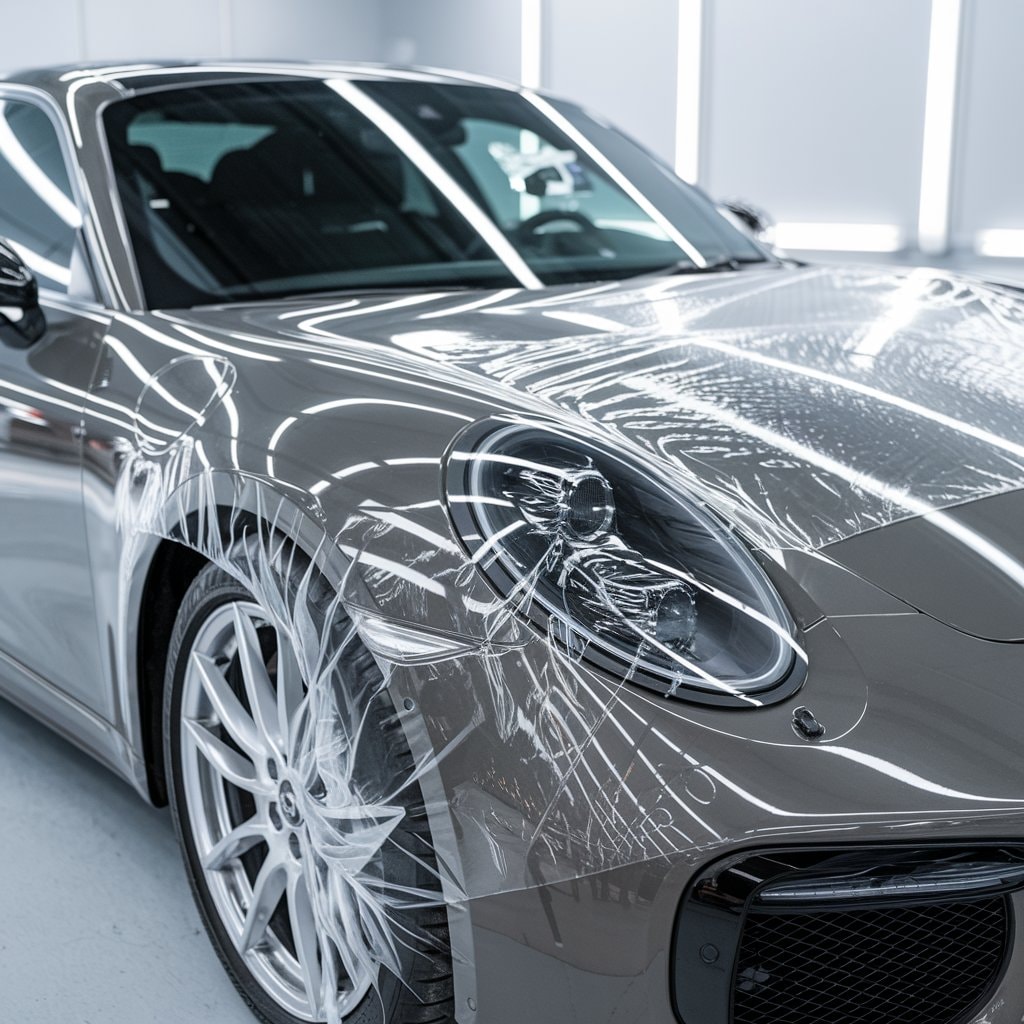
How Much Does Paint Protection Film Cost?
The cost of paint protection film (PPF) can vary considerably based on several factors, including the vehicle’s size, the film’s quality, and the complexity of the installation.
On average, the expense of applying PPF to a car may range from a few hundred to several thousand dollars.
Comparatively, when evaluating other coating options, such as ceramic coatings, PPF tends to be more expensive but offers superior physical protection.
Factors Affecting the PPF Cost
Several factors influence the cost of paint protection film (PPF), making it essential for vehicle owners to evaluate their budget and needs when choosing this type of protection.
Understanding what drives the PPF cost helps in deciding on the right type of paint protection film for your car.
- Coverage Area: Full car coverage costs more than partial treatments, requiring more material and labour.
- Quality of PPF: High-quality PPF offers better durability and finish but at a higher initial cost.
- Installation Complexity: The cost increases with the complexity of the vehicle’s design. More intricate patterns require more precise and labour-intensive work to protect the paint effectively.
Average Cost of PPF Installation
Understanding the average cost of paint protection film (PPF) installation is essential for car owners considering this investment.
The cost of PPF coating varies primarily based on the size of the vehicle and the coverage area. Installing PPF on an entire vehicle in India typically ranges from ₹1,25,000 to ₹5,80,000. This variation depends on whether you opt for partial or complete coverage, with full wraps offering a more comprehensive and cost-effective solution for long-term paint protection. Higher-quality films with advanced self-healing properties or hydrophobic features may also influence the price.
Labour costs also play a significant role, as the meticulous application process requires precision. Established and reputable installers often charge more but guarantee higher quality and durability.
Typically, a detailing studio offering PPF services will provide a quote based on these three factors mentioned above.
Comparing PPF with Other Coating Options
Paint protection film cost might initially seem high, but it offers unique benefits compared to alternatives like ceramic coatings and regular wax.
- Longevity: PPF offers a more durable solution, with some of the best PPF in India lasting up to 10 years, markedly outperforming ceramic options regarding lifespan.
- Self-healing properties: High-quality protection films include self-healing technology that helps repair minor scratches and swirls caused by everyday use, maintaining the vehicle’s aesthetic appeal.
- Enhanced resale value: The robust protection that PPF coating provides can preserve the vehicle’s original paint, potentially increasing the vehicle’s resale value compared to cars with lesser or no paint protection.
Choosing the proper paint protection guarantees long-term savings and maintenance benefits.
What Are the Different Types of PPF Available?
When considering paint protection films (PPF), consumers can choose between gloss or matte finishes, each offering distinct aesthetic appeals and protective qualities.
Selecting the most suitable PPF for a vehicle involves evaluating durability, maintenance, and cost.
Additionally, self-healing PPFs represent a significant advancement by providing enhanced protection that automatically repairs minor scratches and scuffs.
Exploring Gloss PPF vs. Matte PPF
How do you choose between gloss and matte paint protection films (PPF)? Both types of PPF available offer superior protection for the exterior of your car, but they differ in finish and performance under certain conditions.
Gloss PPF, a thin film that is applied directly over the car’s paint, guarantees a shiny, wet look that enhances the vehicle’s color. Matte PPF, tinted film on the other hand, provides a stealthy, flat finish that is less prone to showing scratches and chips than gloss PPF.
- Aesthetic Preference: Gloss enhances colour; matte offers a subdued, unique look.
- Maintenance Level: Gloss requires more maintenance to keep its shine; matte requires less maintenance.
- Durability: Both offer protection film with an industry-leading multilayer design for lasting durability.
Choosing the Best PPF for Your Vehicle
Selecting the ideal paint protection film (PPF) for your vehicle involves understanding the different types available, each tailored to suit specific needs and preferences.
Various PPF brands offer a range of products that promise superior protection for your vehicle’s paint. Premium PPF typically features advanced characteristics such as enhanced durability and invisible protection, ensuring the car’s paint remains unblemished.
The paint protection film cost varies depending on these advanced features and the brand selected. Proper maintenance of the PPF can extend its life and maintain its effectiveness.
Consumers should consider these factors carefully when choosing the PPF that offers the best protection while aligning with their budget and willingness for maintenance.
Self-Healing PPF: How It Works and Why It’s Worth It
Among the innovative options in paint protection films, self-healing PPF stands out due to its unique ability to repair itself. This advanced paint protection film incorporates a thin layer of transparent film applied directly to the car’s paint.
Its primary function is to shield the surface from swirl marks, minor scratches, and other blemishes. Here are key features that make self-healing PPF a compelling choice:
- Self-Healing Properties: Activated by heat, the film can repair minor scratches, maintaining a pristine finish.
- Multilayer Protection: This protection film, which has an industry-leading multilayer structure, offers enhanced durability.
- Long-Term Value: Despite a higher price tag, the robust protection for your vehicle’s paint justifies the investment.
Can PPF Be Installed on Any Car?
Paint protection film (PPF) can be applied to virtually any car, but certain factors influence its suitability and effectiveness.
Before starting the installation, it’s crucial to understand the specific steps involved and assess whether a vehicle’s condition and model are ideal for such an application.
These considerations guarantee that the film adheres appropriately and provides optimal protection for the intended protection.
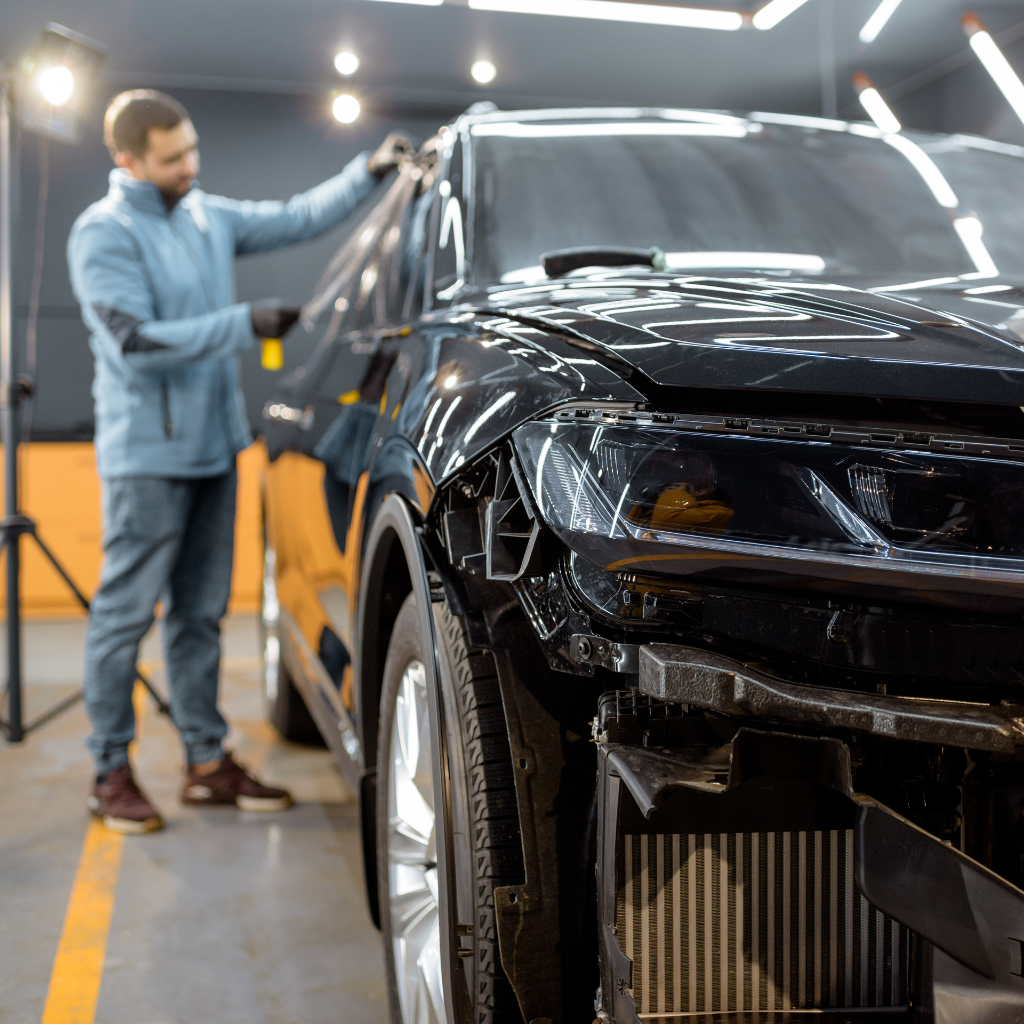
Suitability of PPF for Cars
While paint protection film (PPF) is widely applicable, its suitability varies depending on the vehicle’s condition.
Paint protection film cost and effectiveness depend mainly on the car’s paint and overall surface integrity. Installing a PPF car cover provides robust protection for your vehicle’s paint, but not every vehicle is a good candidate.
- Condition of Paint: Vehicles with damaged or extensively worn paint may not benefit fully from applying paint protection film.
- Body Shape: Some complex curves or edges can challenge the application, reducing effectiveness.
- Type of Vehicle: High-end cars might often see the most benefit, incorporating protection film with an industry-leading multilayer to safeguard their valuable exterior.
Choosing to armour a car with paint protection film can considerably shield the entire car, enhancing the longevity and aesthetics of the vehicle’s paint.
Steps to Install PPF on Your Vehicle
Installing paint protection film (PPF) on your vehicle involves several precise steps to confirm ideal coverage and protection.
Initially, the car’s paint is meticulously cleaned and prepped to confirm no contaminants interfere with adhesion.
Next, a professional applies the PPF, starting typically with the hood and moving toward door edges and the sides, carefully aligning the film to avoid bubbles and wrinkles.
This basic PPF layer is a barrier against road debris, stone chips, and everyday wear, offering essential scratch protection for your vehicle’s paint.
The final step involves curing the film under a heat source to solidify the bond, enhancing the durability and effectiveness of the protection.
This process underscores how much paint protection film cost influences the long-term preservation of a vehicle’s paint.
Factors to Consider Before Applying PPF to Your Car
Before applying paint protection film (PPF) to Several key factors must be considered for your vehicle to guarantee the installation’s effectiveness and appropriateness.
Here are three key considerations:
- Type of PPF: Not all PPFs are created equal. The PPF provides varying degrees of protection for your vehicle’s paint, with some offering a protection film with an industry-leading multilayer structure.
- Vehicle Condition: The current state of your car’s paint is vital. PPF is a transparent film and will not hide imperfections; it can even highlight them if the paint is not adequately prepared.
- Brand and Cost: Choosing the right brand of PPF in India and understanding the coating price are essential for budgeting and quality assurance.
Is PPF Installation Worth the Investment?
When considering whether paint protection film (PPF) is worthwhile, one must analyze its long-term benefits against the initial cost.
Comparing the expense of PPF installation with the potential costs of repairing paint damage reveals significant insights.
Additionally, determining whether PPF or traditional paint repairs offer more savings over time can help car owners make financially sound decisions.
Long-term Benefits of Car Paint Protection Film
Although the initial cost of paint protection film (PPF) may seem steep, the long-term benefits justify the investment for many vehicle owners.
Installing a protection film with an industry-leading multilayer design on your car’s paint can safeguard against numerous potential damages and maintain the vehicle’s aesthetic value.
Here are three key long-term benefits:
- Protection from Environmental Damage: PPF can help protect the vehicle’s paint from harmful UV rays and chemical stains, keeping your car looking new longer.
- Reduces Need for Paint Correction: Regular maintenance and potential paint correction costs are minimized as the film preserves the original paintwork.
- Enhances Resale Value: A well-maintained exterior is a valuable investment for any car, potentially increasing its market value.
Comparing PPF Cost with Potential Damage to the Paint
Can the cost of installing paint protection film (PPF) genuinely outweigh the potential expenses incurred from paint damage over a vehicle’s lifespan. When considering protection for your vehicle’s paint, PPF offers a robust shield against environmental elements that degrade the car’s paint over time. With an industry-leading multilayer design, this protection film can effectively guard vulnerable areas such as the front bumper, rocker panels, and side mirrors.
| Area Protected | Cost of PPF Installation | Potential Paint Repair Cost |
|---|---|---|
| Front Bumper | ₹25,000 – ₹42,000 | ₹50,000 – ₹84,000 |
| Rocker Panels | ₹21,000 – ₹34,000 | ₹42,000 – ₹67,000 |
| Side Mirrors | ₹8,400 – ₹17,000 | ₹12,500 – ₹25,000 |
This table illustrates the financial rationale behind choosing PPF coating as a preventive investment for maintaining the aesthetics and value of a vehicle.
PPF vs. Paint Repairs: Which Saves More in the Long Run?
Given the data comparing the paint protection film installation costs and potential paint repair expenses, PPF can be a financially sound decision in the long term.
When evaluating PPF vs. paint repairs, several factors favour the former:
- Longevity: PPF is made with an industry-leading multilayer film that shields the car’s paint from scratches and weather effects, reducing the frequency and need for costly paint repairs.
- Cost-Effectiveness: Over time, the initial paint protection film cost can be less than the cumulative expenses you’d pay to repair your paint after damages.
- Resale Value: Protection for your vehicle’s paint helps maintain the car’s aesthetic and structural integrity, potentially boosting resale value compared to a vehicle with multiple paint repairs.
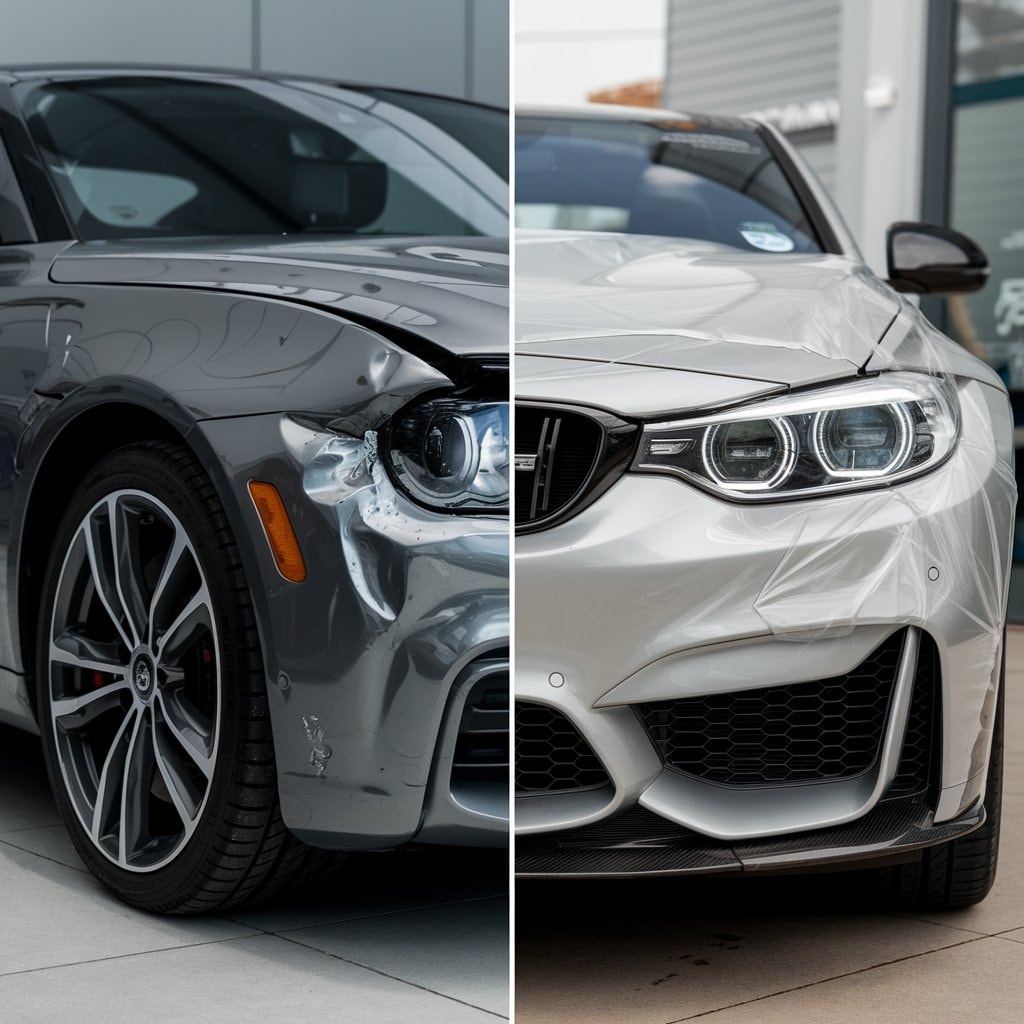
Conclusion
Paint Protection Film (PPF) offers valuable vehicle protection, shielding the paint from scratches, stains, and weather damage. While the cost of PPF can vary based on the type and coverage, the investment is generally considered worthwhile for maintaining a car’s aesthetic and resale value. Available in various types and applicable to any car, PPF installation is an ideal option for keeping your vehicle’s condition and appearance over time.


